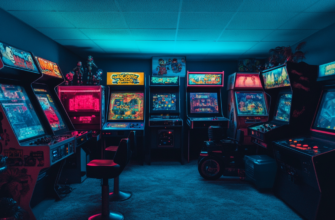- What’s stopping VR games from going mainstream?
- High upfront costs: not everyone can afford VR
- Practical tip: watch for sales and bundles
- Motion sickness: VR isn’t comfortable for everyone
- Practical tip: take breaks and start slow
- VR game titles: lack of AAA content
- Practical tip: look into VR mods
- Comfort issues: VR headsets aren’t always great for long sessions
- Practical tip: upgrade to comfort-focused accessories
- Limited physical space: not everyone has room for VR
- Practical tip: dedicated play zone
- The social stigma and isolation factor
- Practical tip: integrate VR with traditional gaming
- Conclusion: is VR getting there?
What’s stopping VR games from going mainstream?
Let’s be real here—everyone thought VR games would be the next big thing in gaming. Back when VR first came onto the scene, a lot of people (myself included) expected it to take off in the same way multiplayer online games or mobile gaming did. But here we are, years later, and VR still hasn’t captured more than a niche audience. So, what gives? In this article, let’s dive into why VR games haven’t gone fully mainstream yet.
High upfront costs: not everyone can afford VR
One of the biggest challenges holding VR from becoming a household name is that it’s expensive—like, really expensive. To get into VR gaming, you’re looking at not just a good PC or console, but also a VR headset, which can set you back anywhere from $300 to $900 depending on the brand and whether you want additional accessories.
Let’s not forget that if you’re a PC gamer, you’ll need a relatively beefy rig to run more intensive VR games. Graphics cards like NVIDIA’s 3070 or better are often recommended, which means if your PC isn’t up to snuff, you may need to upgrade. And let’s face it, upgrading a gaming rig isn’t cheap. This initial cost is definitely a deterrent for many gamers who could just buy a $60 game for their console instead of committing a few hundred bucks to try VR.
Practical tip: watch for sales and bundles
If you really want to dive into VR but have a tight budget, keep your eyes on special bundles or holiday discounts. Companies like Oculus and PlayStation usually offer deals that include free games when you purchase a new headset. Also, keeping an eye on refurbished models can save you a good bit of cash without sacrificing functionality.
Motion sickness: VR isn’t comfortable for everyone
If you’ve ever felt dizzy or nauseous after a VR session, you aren’t alone. Motion sickness is a pretty common issue among VR gamers. This happens because your brain has a hard time reconciling the movement in the game world with the fact that your body is standing still in reality.
I don’t know about you, but if a game makes me feel like I just got off a roller coaster after 15 minutes, I’m probably not going to jump back into it anytime soon. Many VR games have tried to account for this by offering teleportation-based movement systems instead of natural walking, but this isn’t a universal fix. So, while some people can spend hours in VR without a hitch, others might barely make it an hour without needing to sit down.
Practical tip: take breaks and start slow
If you’re prone to motion sickness in VR, don’t jump into a game for hours at a time. Start with short 10-15 minute sessions and gradually increase your playtime once your body gets used to the experience. It also helps to take breaks, like getting a bit of fresh air or walking around after a session.
VR game titles: lack of AAA content
While VR-exclusive titles are cool and all, they haven’t yet matched up with the blockbuster AAA games on desktop or console that regularly push the boundaries of gaming. Most of us are still playing games on a flat screen because, frankly, that’s where the best games are right now.
Developers usually create VR-specific games, but they tend to be smaller in scale and budget. Don’t get me wrong, games like “Half-Life: Alyx” and “Beat Saber” are great, but there really aren’t that many games at that level of polish and content. You’ll mostly find experimental games or simple experiences that lack depth, which makes it hard to justify the hardware investment.
Practical tip: look into VR mods
If you’re on the hunt for more VR content, look into VR mods for existing games. Some communities have created mods for non-VR games like “Skyrim” and even “GTA V,” giving you a chance to dive into more expansive worlds in virtual reality. Just keep in mind that these mods aren’t always perfect.
Comfort issues: VR headsets aren’t always great for long sessions
Beyond the motion sickness issue, there’s also the simple fact that VR headsets aren’t the most comfortable things to wear for long periods of time. After an hour or two, the headset can feel pretty heavy or cause your face to get sweaty. Most people (myself included) just don’t want to deal with this every time they want to play a game.
Some newer models like the Oculus Quest 2 or HTC Vive Pro have tried to make headsets lighter and more ergonomic, but they haven’t entirely solved the issue of comfort. And if you wear glasses? Yeah—it’s even more of a pain to get everything positioned right without feeling like your frames are digging into the sides of your head.
Practical tip: upgrade to comfort-focused accessories
If you already own a VR headset but struggle with comfort, invest in better accessories. You can find aftermarket head straps that improve the weight distribution of your headset, and there are plenty of third-party face cushions that are much nicer than the stock ones that come with most consumer headsets.
Limited physical space: not everyone has room for VR
Another major barrier to entry for VR gaming is the space needed to truly enjoy these experiences. Let’s face it, most of us don’t have an entire room dedicated to gaming, and VR games—especially the ones that encourage full-body movement—demand quite a bit of space.
It’s fine for games where you’re just standing or sitting in one spot, but for room-scale VR experiences, you’ll need at least a couple of square meters of free space. This just isn’t a reality for people living in small apartments or cluttered rooms. For many gamers, this becomes a logistical nightmare. It’s not super fun to play a game when you’re constantly worried about knocking over your lamp or trashing the room.
Practical tip: dedicated play zone
If you’re tight on space, designate a specific play zone for your VR setup, even if it means rearranging a few pieces of furniture before each session. You can use room boundary systems (like the guardian feature on Oculus headsets) to avoid running into objects or walls during gameplay.
The social stigma and isolation factor
Let’s be honest, gaming is a social activity for a lot of people. Whether you’re chatting with friends over Discord or competing in multiplayer gaming, interaction with others is a huge part of why so many gamers love this hobby. But VR? It’s a pretty isolating experience right now.
The current design of VR headsets generally pulls you out of the social gaming loop. It’s hard to interact with friends who aren’t also playing in VR, and multiplayer VR games are still relatively limited compared to traditional games. Sure, there are online games like “VRChat,” but outside of niche communities, the majority of multiplayer games still happen on non-VR platforms.
Practical tip: integrate VR with traditional gaming
Some VR games offer both VR and non-VR modes, like “No Man’s Sky” and “Star Wars: Squadrons.” By choosing games that support both modes, you can still play with friends who don’t have VR and keep that social element alive. This hybrid approach lets you jump into VR when you want while staying connected with your broader gaming group.
Conclusion: is VR getting there?
VR gaming has made huge strides, and there’s no denying the super cool tech behind it. However, those of us waiting for it to fully dominate gaming like consoles or PC still have to wait. At this point, there are too many factors—price, hardware limitations, comfort, space, and available games—that prevent VR from being more accessible to the mainstream audience.
Does this mean VR’s future is bleak? Probably not. As hardware gets cheaper and more games become available, it’s likely that VR will eventually become more popular with average gamers. In the meantime, if you already own a VR device or are thinking about getting one, it’s worth exploring the market and taking steps to work around some of the smaller issues that are keeping VR from truly popping off.
If you’re still on the fence about jumping into VR, try doing more research, watching gameplay videos, and considering how much time you’ll actually spend with the headset before making a decision. If you think I missed anything or have questions, feel free to hit me up in the comments. Let’s see where the future of VR takes us!

















